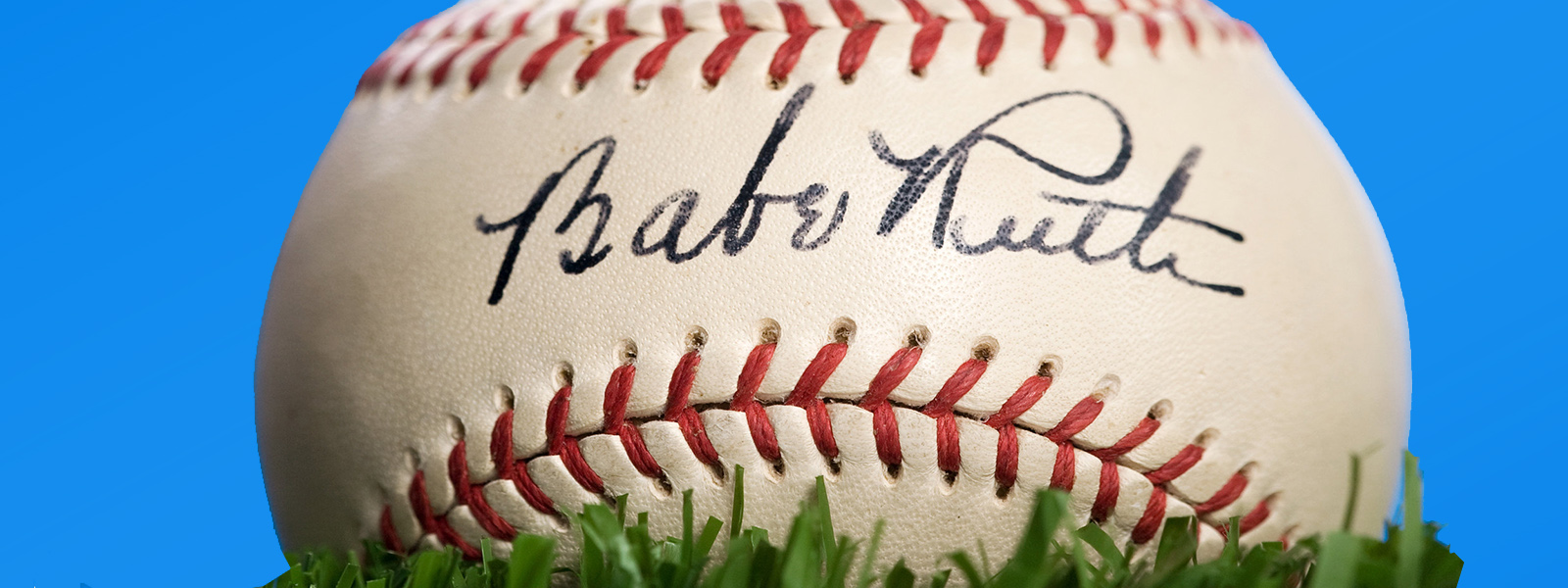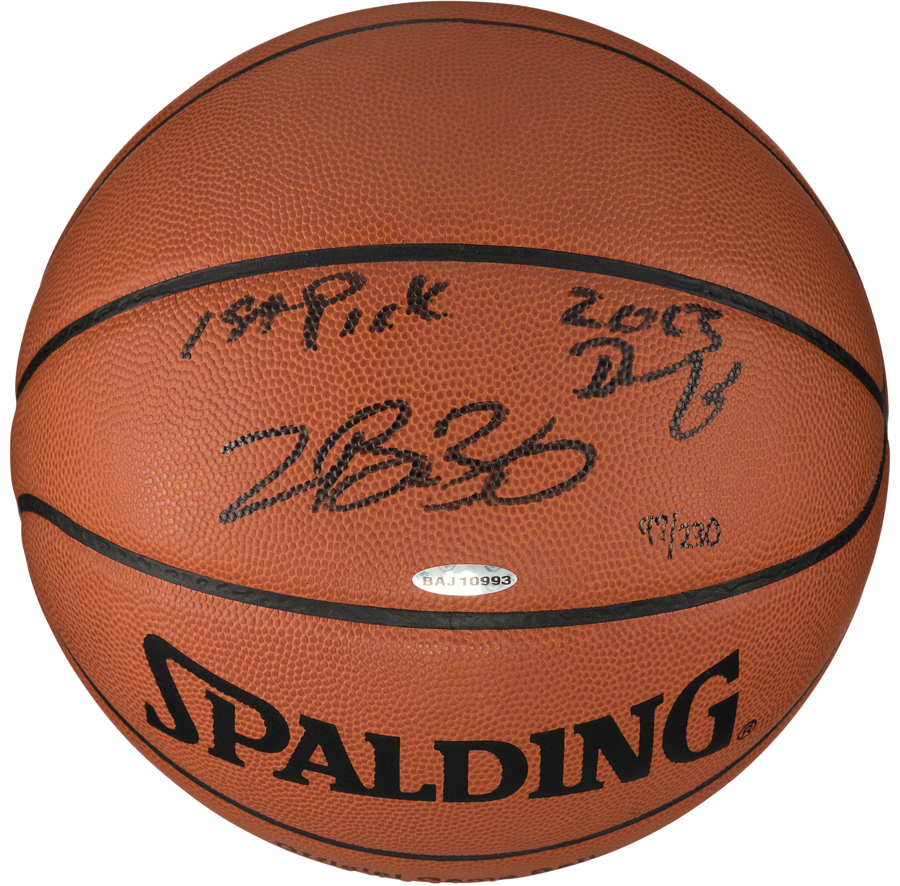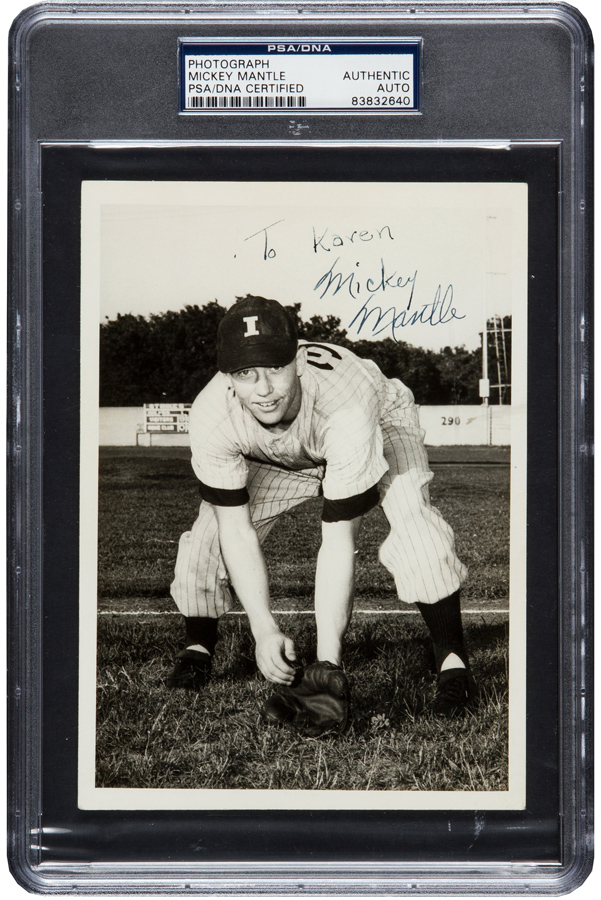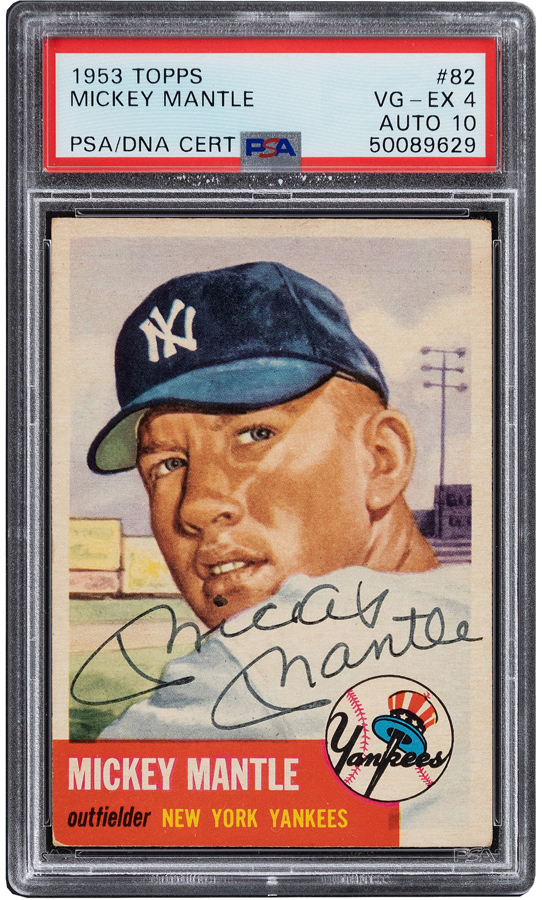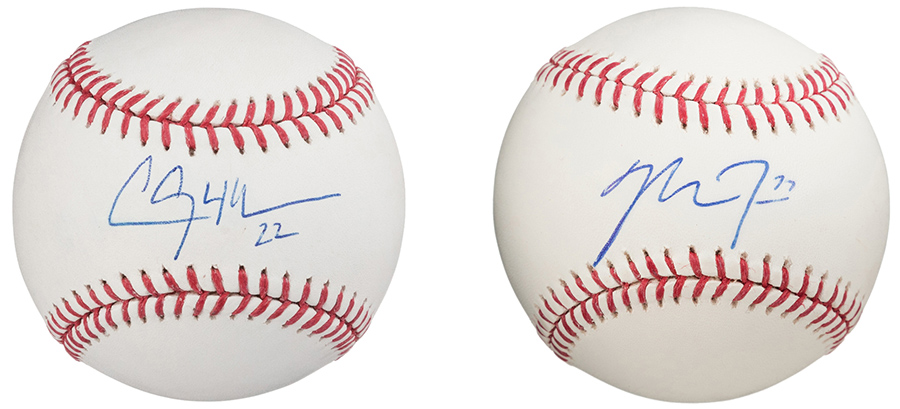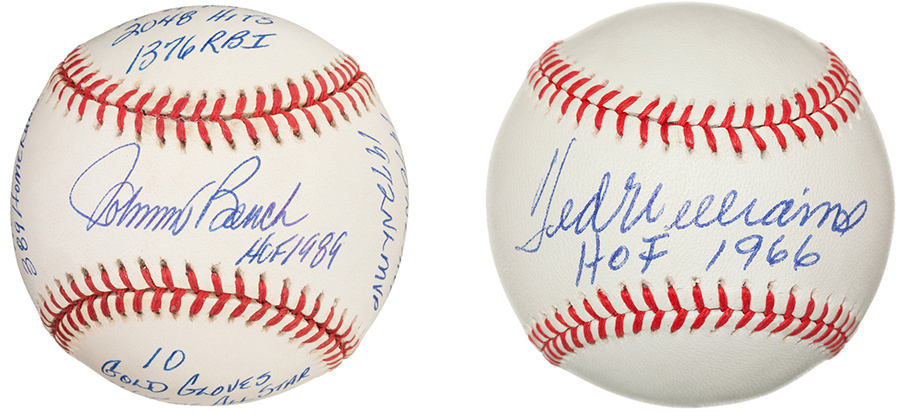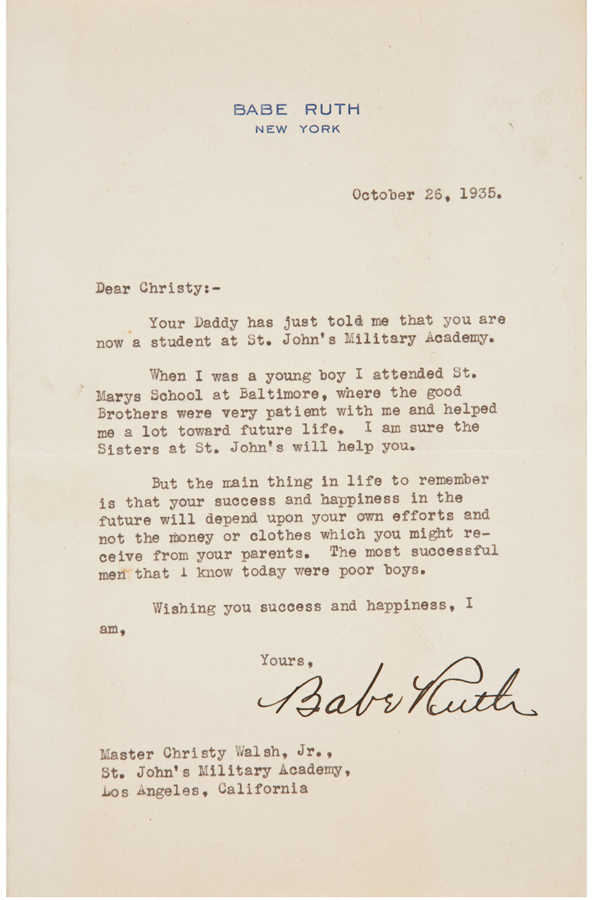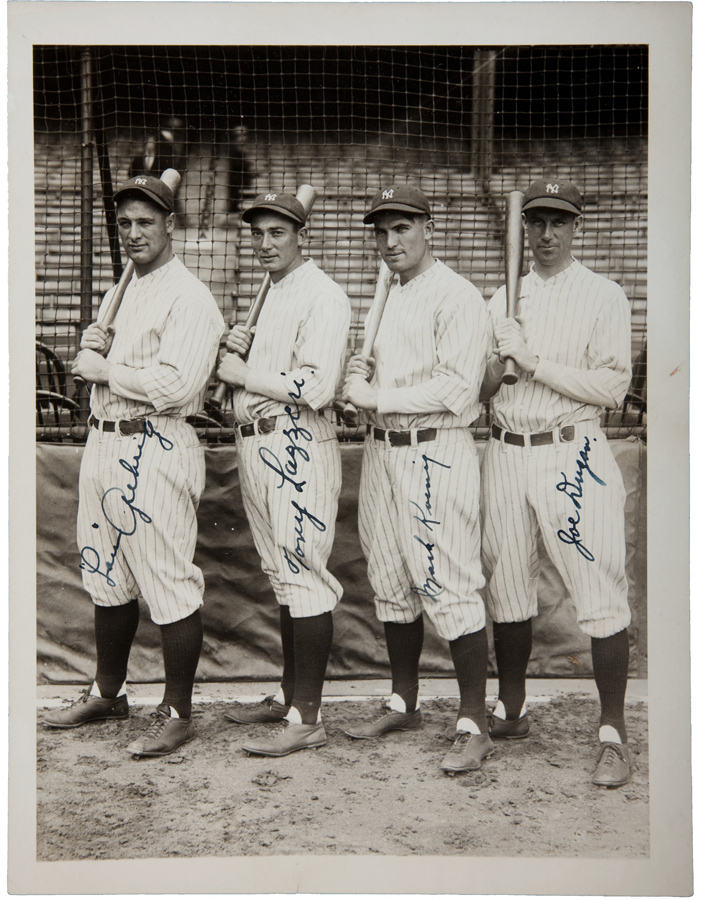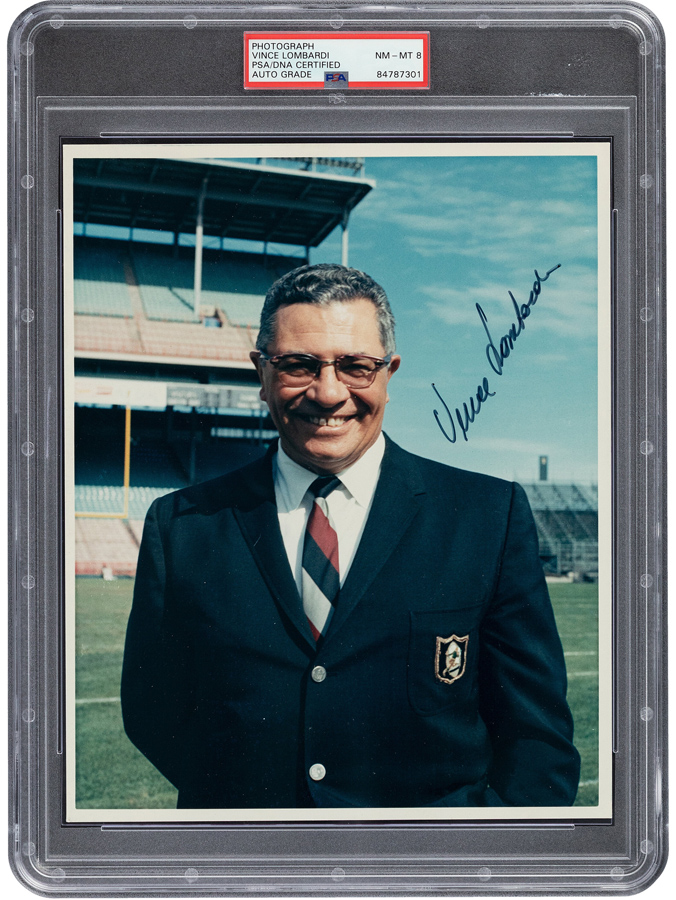BEFORE STOCKPILING SIGNATURES, UNDERSTAND THE PIVOTAL FACTORS THAT CAN IMPACT THEIR VALUE
By Joe Orlando
Enlarge
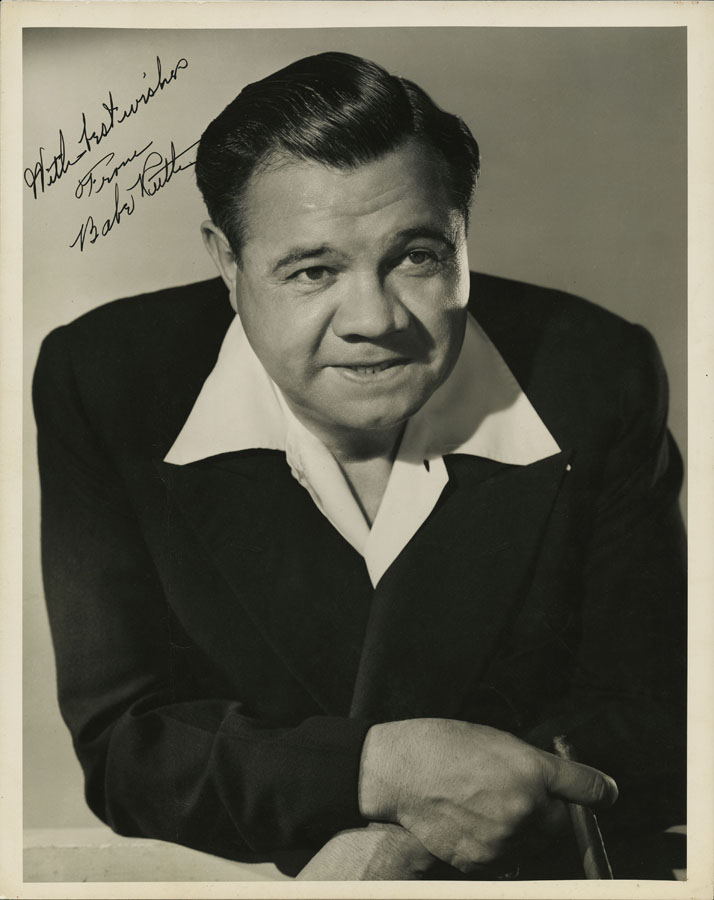
The terrific placement of Babe Ruth’s autograph on this oversized photo from the H&B archives makes all the difference when it comes to eye appeal.
It has often been said that one’s eyes are the window to the soul, but if you talk to autograph collectors, some of them will say the same about one’s signature. A part of an individual’s personality is revealed when they stroke their name on an object ready to receive it. It is an art form that has gradually dissipated as the digital age requires less from people in the way of penmanship.
An autograph is not only a window to the soul, but it can also capture the signer during a specific period or function as a time capsule to a bygone era altogether. Unlike manufactured collectibles such as trading cards and non-manufactured relics like game tickets, a personal touch is required here. That is the connection. It brings the collector a little bit closer to the larger-than-life figures who seemed more than human on occasion. For a moment in time, the medium had their undivided attention and received their grace.
A simple scribble from those skilled enough to play at the highest level of sport transforms the item into something more than what it was without the signature. A signed collectible of any kind is treated altogether differently by the hobby than the same thing unsigned. It joins an exclusive club and requires its own category. In most cases, the autograph acts as an enhancement to whatever it touches. The autograph can also help frame the piece in an entirely different way by providing provenance, content or context.
For those interested in exploring sports autograph collecting, we present a hobby guide containing the key factors that can impact demand and, ultimately, value.
Respected suppliers with recognized brands offer collectors an opportunity to acquire authentic autographs, like these two UDA (Upper Deck Authenticated) basketballs signed by NBA icons Michael Jordan (top) and LeBron James (below).
Authentication or Bust: A Respected Opinion or Supplier Is Key
Of all the different third-party service types within the sports collecting hobby, one could argue that autograph authentication might be the most challenging for those tasked with the responsibility. The level of difficulty for those issuing the opinions can vary from signature to signature, from medium to medium, in a way that differs from most other sports collectibles. In other words, the variables in play that can impact the authentication process appear endless at times.
That said, the same basic principle that is so critical to other collectible types applies in the autograph world as well. It is imperative that collectors buy certified autographs for maximum future liquidity and resale potential. This is even more vital when it comes to any signature of significant monetary value. Without proper autograph authentication, it can become an all or nothing proposition for many buyers.
► More Collector’s Guides
For additional collecting advice on topics ranging from fine minerals and rare books to art glass and action figures, visit our dedicated Collector’s Guide page.
This principle remains fundamental even if you witnessed the items being signed yourself. When you decide to sell or trade the autograph, or pass it down to members of your family, there will be a time when a prospective buyer or bidder will need third-party assurance to feel comfortable paying top dollar. In fact, absent that stamp of approval, they might not be willing to purchase the autograph at any price. Your personal knowledge of its signing might help establish provenance, but without a blessing from a credible brand, maximum value will not be achieved.
It is also important that buyers can recognize reputable autograph suppliers, ones that certify the items during the signing and sell them, in addition to respected third-party authentication companies that often review items on their own merit after they have been signed or act as a witness during a signing as part of their in-the-presence services. The brand providing the certification is as important here as it is with sports cards or any other kind of memorabilia, maybe even more so.
Some third-party companies provide an additional service of grading, which is the evaluation of the autograph’s condition once authenticity has been determined. The services grade on a scale of 1 to 10, with 10 being best, just like it is in the card world. Remember to pay attention to preservation because an autograph’s condition can change, arguably more than any other collectible type, if not cared for properly.
Finally, unlike the card-grading world, it is not uncommon for signed items to come with more than one third-party opinion. It is not a requirement, but it certainly does not hurt to have additional positive conclusions if the opinions are rendered by prominent brands and the autographs at issue are expensive.
Experts, even the best of them, will sometimes disagree with one another about authenticity. This is true in every field, but it happens more often in autographs than any other segment of sports collectibles. What matters most is that your item has the backing of a brand that is highly regarded in the industry, even when consensus among the experts is not reached.
Key takeaway: The brand power behind autograph authentication, provided by a reputable supplier or third-party service, is essential to resale potential.
It is important for collectors to learn how autographs from different sports figures evolved over time. The three Mickey Mantle autographs pictured here, which date from Mantle’s minor league days (top) to the middle of his MLB duty (center) to his post-playing career (bottom), show how some signatures can go through a major metamorphosis.
Acquaint Yourself With the Evolution of a Person’s Signature
If people new to the hobby were presented with a rookie-era Mickey Mantle signed item along with one signed either during the middle of the Yankee legend’s career or near the end of his life, most individuals would not believe the same person penned both autographs. In the case of Mantle, you can see the evolution of the athlete and his confidence through his signature metamorphosis.
The small-town prospect became the biggest name in the game, and his signature development tells the story. From the simplistic scrawl of his early days to one of the most recognizable, stylistic autographs of any generation, Mantle’s signature is a window into the man. It went from caterpillar to butterfly once the Commerce Comet started to soar.
Mantle is just one autograph study, but it is a terrific example. Buyers should familiarize themselves with changes that take place over an athlete’s career and life. An athlete’s signature can change just like ours do, except that even more dramatic penmanship transformations are likely to occur as athletes become celebrities. Once they become recognizable public figures, athletes are frequently asked to sign their name. The sheer number of times these idols will sign their names over the course of their lifetimes goes far beyond what most mortals experience.
Once you can recognize an athlete’s signature patterns, you can begin connecting some of those documented styles to separate times of their life. You can also start recognizing the scarcity of certain signature styles, which can impact price as well. Does the signature contain the figure’s formal name or the nickname they became most known for, such as “George” versus “Babe” when it pertains to Mr. Ruth?
There is a lot to learn here, but there are resources to help. Studying documents that appear in the marketplace such as contracts and using online guides like PSA AutographFacts are wonderful places to start.
Key takeaway: Following the life of a signature and being able to identify certain styles can provide opportunities to narrow dating and spot potential value.
The art of signing one’s name, and writing in general, has changed dramatically over the past two decades. The disparity in eye appeal between most vintage autographs and those from the present is often apparent. These Clayton Kershaw and Mike Trout signed baseballs (top row, from left) compared to ones signed by Johnny Bench and Ted Williams (bottom row, from left) clearly illustrate the generational differences.
The Penmanship Predicament: Vintage Versus Modern
When collectors start buying autographs, an important part of the process going into the endeavor is managing expectations. An area where buyers need to temper those expectations, at least as it relates to appearance, is the aesthetic quality of current-era autographs versus vintage ones. Penmanship, in many ways, has become somewhat of a lost art in the age of computers and other smart devices.
There is a clear difference between the legibility, style and eye appeal of autographs emanating from prior generations versus those signed by active stars today. The pride and effort that were once used to write has even impacted the way we, the non-celebrities, sign our names. If this shift has altered the way the average person signs their name, just imagine how it can impact a star athlete or famous figure who is asked to sign a multitude of items.
In fact, some modern-era athletes vary their signature styles depending on the surrounding circumstances. If the athlete finds himself in a more hectic environment, from the ballpark to walking out of a busy restaurant, you might find the resulting signature appearance will reflect the timing of the request. These signatures are often rushed, abbreviated and look altogether different. When paid to take part in a private signing, athletes will frequently take additional time to provide a much more aesthetically pleasing autograph.
While some signers have displayed remarkable consistency, it is important that collectors understand the potential for wide signature variance, even when there has been a general deterioration in handwriting to begin with. Furthermore, if you decide to build a comprehensive collection of autographs, or even a selective one that combines vintage and modern subjects, just prepare yourself for the discernible decline in visual appeal. It is merely a product of the times. Whether a result of the era or the nature of the moment, signatures tend to change with the environment.
Key takeaway: The more aware you are of technology’s impact on handwriting, the more understanding you will be when it comes to autograph appearances.
Autographs are often accompanied by some form of content, which can be of a professional or personal nature. If that content helps tell a story about the figure, it can add significant value to the piece. In these three intriguing letters (pictured from top), Lou Gehrig discusses the illness that now bears his name, Babe Ruth offers his guidance to a young man by sharing his views on desire and discipline, and Jackie Robinson discloses his retirement from the game he helped change forever.
Content Matters Where Content Is Present
There is no doubt that our society has changed immensely when it comes to how we communicate with one another. Our correspondence tends to be much shorter and far less formal than it once was. Most people also prefer digital communication vehicles, versus putting pen to paper. The post-2000 era has brought about a communication revolution that has forever changed our culture and autograph collecting.
There was a time, however, when human beings spent the time to share their thoughts via the written word, either typed or by hand, on tangible mediums. From short inscriptions that date an item or establish provenance to extensive letters that provide social insight, fascinating opinions or expressions of love, content can be crucial when attempting to ascertain the proper price.
Interestingly, in the past, collectors coveted sports-related content over other types. If two Lou Gehrig handwritten letters were offered for sale, the one containing comments about baseball was often thought of as being more valuable than one that focused on more personal subjects. That said, if the more “personal” letter contains commentary about his struggle with the disease that now bears his name, it is a different story altogether.
Other fitting examples might be insight from Muhammad Ali or Jackie Robinson about important social issues, or deeply personal reflections from an athlete who kept much of his life private. Is content evaluation subjective? Yes, but if the content helps tell the athlete’s story in a meaningful way, sports related or not, the piece becomes more appealing.
Even if the content of the piece is not particularly poignant or riveting, its presence brings us a little closer to the person who signed it. The content might simply contain a “Thank You” or some humor from its creator, and that is something that makes our sports immortals human – just like us. The content might reveal an opinion held by, or a seldom seen side of, the star. Furthermore, the content might simply confirm part of the signer’s reputation or story, revealing a commonly held belief about their personality.
The point is that any content offers a glimpse of that moment, no matter how mundane it appears on the surface.
Key takeaway: The story within the story lies within the content of a signed piece.
Sometimes the location of an autograph can be just as important, if not more so, than its condition. The placement of the autographs found on each of these photos, one featuring the 1927 New York Yankees infield and the other featuring football coaching legend Vince Lombardi, exhibits how impactful contrast can be to eye appeal.
Be Aware of All the Additional Factors That Can Impact Value
Throughout this autograph collecting guide, we have discussed valuation factors such as condition and content, but there are plenty more to be cognizant of. Part of what makes autograph collecting interesting is the number of variables that can potentially come into play when appraising different items. How much should you pay for one signed item versus another in the same category? While it is not an exact science, there are pertinent factors to consider in the valuation process.
-
Individual signing habits can vary medium to medium. Sports figures might be prolific signers of certain items, while limiting the signing of others. Sometimes this is the result of a contractual obligation, which can prevent the person from signing specific mediums, or it could simply be the signer’s preference. Other times, the rarity is a result of fewer opportunities. Regardless of the reason behind the low population numbers, some signed mediums can be much tougher to locate than others, which can also impact demand.
-
Provenance and source are becoming more relevant. Third-party authentication services have helped buyers gain much better peace of mind as the autograph market has matured, but some buyers are starting to appreciate the additional layer of provenance, perhaps more than we have seen in the past. As we noted earlier, a stamp of approval from a credible third party is priority one, but exceptional provenance or a recognized source can add a layer of value to any signed item. It helps validate the independent opinion and tell the story of its journey to the market today.
-
Condition + Contrast + Location = Eye Appeal. We covered the fact that condition matters as it relates to the signature, but do not forget that the condition of the medium matters as well. What ultimately creates maximum visual appeal on a signed item is the combination of signature condition, the contrast between the signature and the medium, and signature location.
For example, the mere location of a signature on a photo can improve or detract from its appeal. If a bold signature appears against a lighter background, it tends to stand out more. If the signature is placed against a dark area of the photo, even if it is in perfect condition, it tends to get lost in the image. Collectors covet signatures that “pop.”
-
Personalized autographs and detailed inscriptions can impact demand, and there is a lot to digest. If a personalization connects to another famous individual or it substantiates provenance, it can have a positive influence on value, and on rare occasions, a major one. While this is true, absent the type of connections noted earlier, most buyers prefer non-personalized items, assuming everything else about the piece is equal. Inscriptions, absent personalization, are usually treated differently by collectors. Additions in the signer’s hand such as a date, achievements, stats or a salutation are commonly viewed by collectors as a plus.
Attributes that provide additional advantages are numerous. In this guide, it would be impossible to cover every nuance or potential combination of factors that can distinguish one autograph from another. Being prepared to ask the right kinds of questions when autographed items become available is arguably the most valuable skill one could extract from this resource.
For instance, if we are evaluating a single-signed baseball, paying attention to the details will pay off in the end. Is it an official MLB ball, from the same league as the player, or is it an unofficial ball? Is the ball signed on the sweet spot or the signed panel? What type of pen was used to sign the ball? What color is the ink? These are just sample questions about pivotal factors, with different degrees of importance.
Key takeaway: The factors that impact autographs are plentiful, but the more you learn, the better you will become at assessing value.
Whether you are attracted to the personal touch an autographed item offers or intrigued by the scarcity of an elusive signature variation or signed medium, we hope this guide proves useful on your collecting journey.
 JOE ORLANDO is Executive Vice President of Sports at Heritage Auctions. He can be reached at JoeO@HA.com or 214.409.1799.
JOE ORLANDO is Executive Vice President of Sports at Heritage Auctions. He can be reached at JoeO@HA.com or 214.409.1799.

